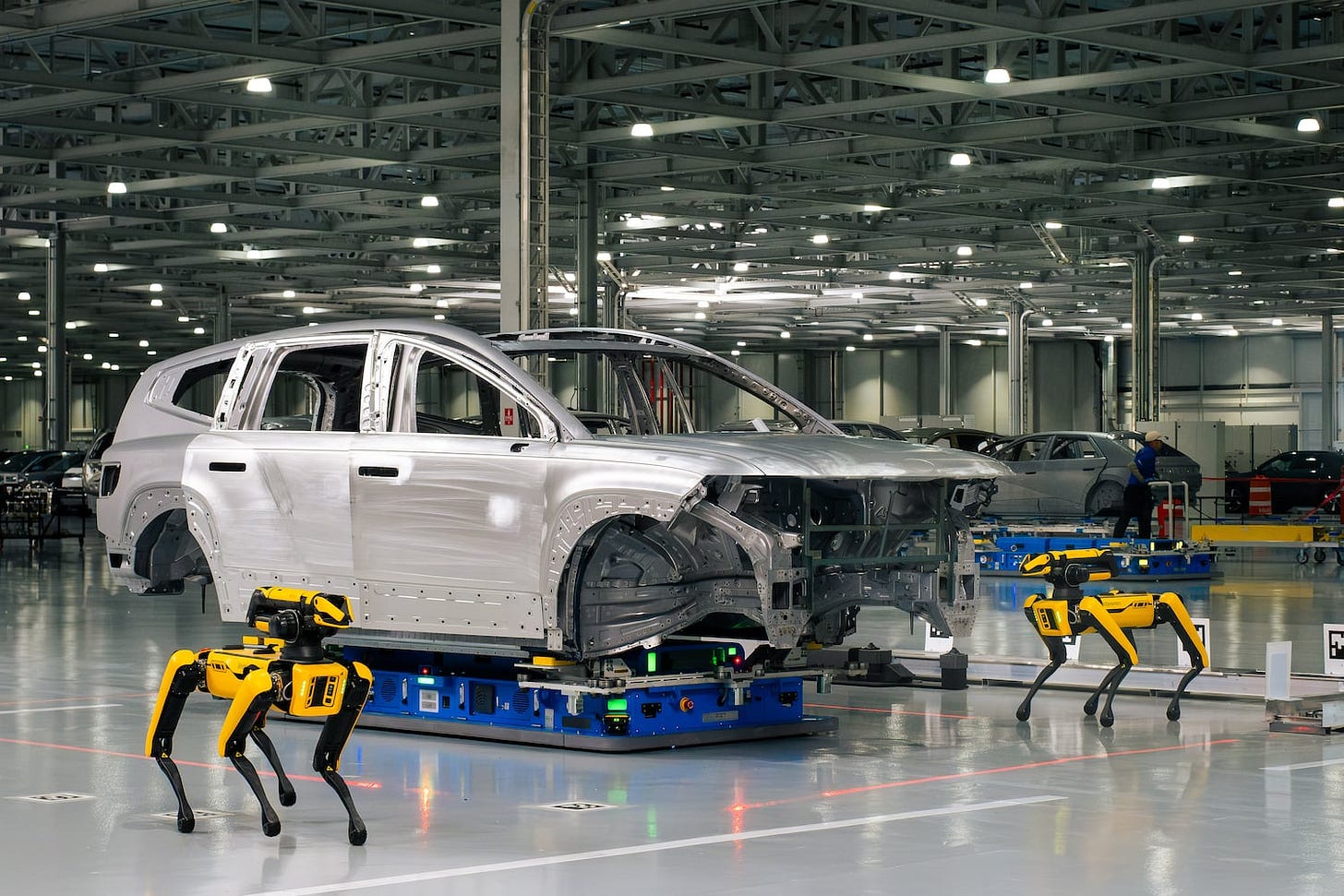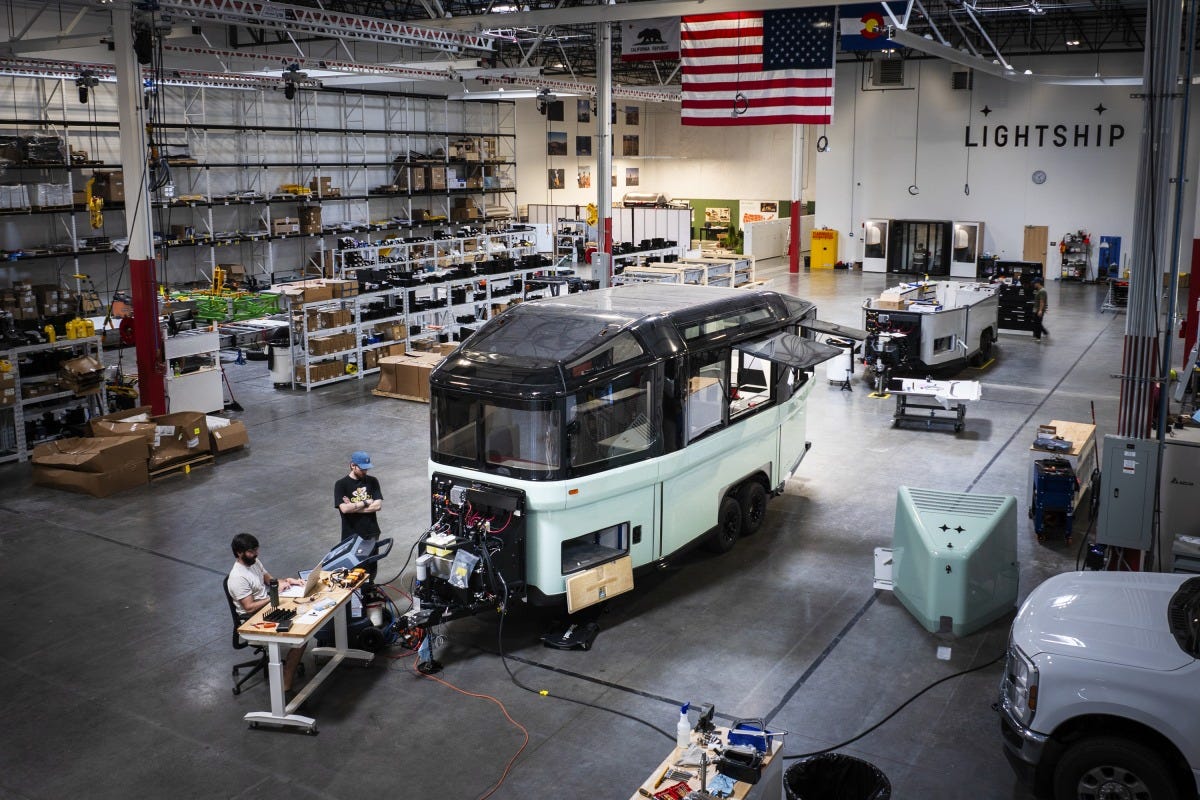HIGH MIX: Rental Robots, Deep-sea Mining, Electric RVs
Reindustrialization news for September 2, 2025
Welcome to HIGH MIX, our weekly newsletter about the reindustrialization of the United States.
“The U.S.′ deep-sea mining plans could hurt its own interests and indirectly benefit China, policy experts say” CNBC
A CSIS report warns that Trump’s executive order from April to fast-track deep-sea mining—both within U.S. waters and beyond—could backfire spectacularly.
The Metals Company’s (TMC) push for licenses in the mineral-rich Clarion-Clipperton Zone, backed by this unilateral move, challenges the UN Convention on the Law of the Sea (UNCLOS) framework, where the U.S. isn’t even a ratified member.
Deep-sea mining targets polymetallic nodules—potato-sized rocks packed with nickel, cobalt, and rare earths critical for EVs and defense—using robotic dredgers that vacuum the seabed. TMC’s application, spurred by Trump’s order, bypasses the stalled International Seabed Authority (ISA), which has yet to set global rules despite decades of talks.
This could erode UNCLOS, the bedrock of maritime law, inviting chaos as nations scramble for claims. China, with its five ISA exploration contracts and advanced submersibles like the Kaituo II, is poised to exploit this vacuum.
CSIS warns this could cede high-seas governance to Beijing, especially if allies like the Cook Islands (also eyeing China deals) defect. Environmental risks—unpredictable ecosystem damage—add another layer, with 38 nations backing a moratorium.
“Tariffs Turn Aluminum Maker Rio Tinto Into Buyer in US Market” BLOOMBERG
Rio Tinto, a global aluminum producer with five smelters in Quebec, is now buying aluminum on the U.S. spot market to fulfill contracts, a direct result of Trump’s 50% tariff on aluminum imports imposed in June.
This shift, driven by a soaring U.S. Midwest premium that jumped 81% since early June to nearly $4,200 per ton (versus $2,600 globally), has forced Rio to purchase at least 50,000 tons domestically since June, down from 723,000 tons shipped pre-tariff in the year’s first half.
Rio, leveraging Quebec’s cheap hydroelectric power, historically supplied 53% of U.S. aluminum imports, but the tariff has made cross-border shipments unviable, pushing the company to source from U.S. rivals instead.
“Rented Robots Get the Worst Jobs and Help Factories Keep the Humans” NYT
There’s been a quiet shift: factories are leasing robotic arms instead of committing to hefty purchases, a trend led by innovators like Universal Robots and Flexiv. It’s also fueled by a 15% spike in automation demand since 2023.
Take a Michigan auto parts maker spotlighted in the article: they’re renting a $50,000 Universal Robot unit for just $1,500 a month, dodging the upfront cost of ownership. Flexiv’s cloud-connected platform lets firms rent specialized arms for six-month stints, ideal for seasonal peaks like holiday toy runs. Industry stats suggest this slashes downtime by 30%, a boon for small shops juggling diverse orders.
Yet, the catch lies in the fine print—proprietary software could tether companies to manufacturer-specific ecosystems, and hidden maintenance fees might nibble away at those savings.
“America’s Newest Auto Plant Is Full of Robots. It Still Needs the Human Touch.” WSJ
The $7.6 billion Metaplant America makes electric vehicles like the Ioniq 5, powered by 750 robots and hundreds of autonomous guided vehicles (AGVs), outpacing the U.S. auto industry’s typical 7-to-1 human-to-robot ratio with its lean 2-to-1 setup.
Robots weld chassis, AGVs shuttle parts, and Boston Dynamics’ Spot dogs patrol with camera-snouts, ensuring weld quality, while Atlas humanoids prep for door-install duties.
The company has committed to hiring 8,500 people at the Ellabell site by 2031 as a condition of the $2 billion incentive package it received from the state of Georgia. But some incoming employees, unnerved by the ubiquity of the plant’s robots, wonder how long they will be able to keep their jobs.
Salem Elzway, a postdoctoral fellow at Vanderbilt University who is writing a book about the history of industrial robots, said they are right to be worried.
“The minute humans become more expensive, more recalcitrant, the more automation you’re going to get,” he said.
Ominous words, but Hyundai’s model shows how automation can bridge labor shortages without fully displacing workers, while fostering a skilled workforce through on-site training. As robots can handle 70% of repetitive tasks, the human edge lies in adaptability (for now).
“Why factory owners are sending their workers to in-house AI academies” FAST COMPANY
Bosch and Danone are training frontline workers to use AI-powered tools, which are rapidly evolving. With only 14% of workers currently AI-literate, this is a core issue as automation is reshaping production.
At Danone, sensors monitor vibrations and temperatures, flagging potential breakdowns, while AI streamlines processes like spray-drying baby formula powder. Bosch’s approach mirrors this, equipping workers with skills to interpret data from AI-driven quality checks.
This is less about replacing workers and more about redefining their role. These in-house academies teach everything from basic machine learning to process optimization, tailored to the shop floor. I think we’ll see more companies opt for the in-house apprenticeship model as tech outpaces formal training institutions.
“The private equity firm that wants to revitalize US manufacturing” MANUFACTURING DIVE
The Manufacturing Revitalization Corporation of America (MRCA), cofounded by Jason Azevedo and Elton Rivas, envisions itself as a catalyst for reindustrialization by blending traditional PE investment with an employee ownership exit strategy.
This approach flips the script on the often criticized "buy, strip, flip" mentality of PE firms, instead prioritizing long-term stability and worker empowerment.
MRCA's strategy is insightful for industry watchers. The firm targets undervalued or distressed manufacturing assets, injecting capital and expertise to turn them around, then transitioning ownership to employees through mechanisms like employee stock ownership plans (ESOPs).
Their portfolio company, Wells—a custom furniture manufacturer—serves as a prime example, where this model has stabilized operations and aligned worker incentives with company growth. Azevedo and Rivas emphasize that this isn't charity; it's smart business, drawing on data showing ESOP companies boast 2.5 times higher productivity and 25% lower turnover rates, per NCEO studies.
By avoiding short-term flips, MRCA could soften the PE industry's reputation for asset-stripping, which has led to 1.3 million job losses in the past decade, according to a 2024 Private Equity Stakeholder Project report.
MRCA's model offers valuable insight: private equity doesn’t have to be predatory and Machiavellian. By successfully prioritizing revival and employee ownership over extraction, it could inspire a change in how PE firms craft their strategy.
“Colorado factory creates first electric RV in America” CBS NEWS
The open road feels a bit greener, thanks to a Colorado factory in Broomfield that’s birthed America’s first all-electric recreational vehicle.
Lightship, a startup founded by Tesla and Rivian alums Toby Kraus and Ben Parker, make a self-propelled (but also towed) camper with a high-voltage battery pack, and 80% U.S.-sourced components.
Each RV features a retractable canopy that lowers for towing, reducing drag by 40%—a lesson born from Kraus and Parker’s harrowing Tesla road trip through headwinds. Solar panels atop the roof juice the 80-kilowatt-hour battery, promising off-grid power for a week, while all-electric appliances like dishwashers cater to the modern camper.
Yet, claiming “first” may overlook competitors like Winnebago and THOR, already dabbling in electric prototypes, suggesting Lightship might be racing to claim a crowded flag. The steep cost—$184,000 for the top-tier Atmos—also raises questions about who can afford this green dream.
Price tag aside, Sustainable Americana is something I’d like to see more of.




